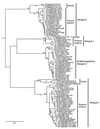Evolutionary relationships of endemic/epidemic and sylvatic dengue viruses
- PMID: 10708439
- PMCID: PMC111823
- DOI: 10.1128/jvi.74.7.3227-3234.2000
Evolutionary relationships of endemic/epidemic and sylvatic dengue viruses
Abstract
Endemic/epidemic dengue viruses (DEN) that are transmitted among humans by the mosquito vectors Aedes aegypti and Aedes albopictus are hypothesized to have evolved from sylvatic DEN strains that are transmitted among nonhuman primates in West Africa and Malaysia by other Aedes mosquitoes. We tested this hypothesis with phylogenetic studies using envelope protein gene sequences of both endemic/epidemic and sylvatic strains. The basal position of sylvatic lineages of DEN-1, -2, and -4 suggested that the endemic/epidemic lineages of these three DEN serotypes evolved independently from sylvatic progenitors. Time estimates for evolution of the endemic/epidemic forms ranged from 100 to 1,500 years ago, and the evolution of endemic/epidemic forms represents relatively recent events in the history of DEN evolution. Analysis of envelope protein amino acid changes predicted to have accompanied endemic/epidemic emergence suggested a role for domain III in adaptation to new mosquito and/or human hosts.
Figures


Similar articles
-
Dengue emergence and adaptation to peridomestic mosquitoes.Emerg Infect Dis. 2004 Oct;10(10):1790-6. doi: 10.3201/eid1010.030846. Emerg Infect Dis. 2004. PMID: 15504265 Free PMC article.
-
Potential of ancestral sylvatic dengue-2 viruses to re-emerge.Virology. 2007 Feb 20;358(2):402-12. doi: 10.1016/j.virol.2006.08.049. Epub 2006 Oct 2. Virology. 2007. PMID: 17014880 Free PMC article.
-
The history and evolution of human dengue emergence.Adv Virus Res. 2008;72:1-76. doi: 10.1016/S0065-3527(08)00401-6. Adv Virus Res. 2008. PMID: 19081488 Review.
-
Potential role of sylvatic and domestic African mosquito species in dengue emergence.Am J Trop Med Hyg. 2005 Aug;73(2):445-9. Am J Trop Med Hyg. 2005. PMID: 16103619
-
Molecular evolution of dengue viruses: contributions of phylogenetics to understanding the history and epidemiology of the preeminent arboviral disease.Infect Genet Evol. 2009 Jul;9(4):523-40. doi: 10.1016/j.meegid.2009.02.003. Epub 2009 Feb 13. Infect Genet Evol. 2009. PMID: 19460319 Free PMC article. Review.
Cited by
-
Genetic and phenotypic characterization of sylvatic dengue virus type 4 strains.Virology. 2012 Feb 5;423(1):58-67. doi: 10.1016/j.virol.2011.11.018. Epub 2011 Dec 16. Virology. 2012. PMID: 22178263 Free PMC article.
-
Molecular Characterization and Viral Origin of the First Dengue Outbreak in Xishuangbanna, Yunnan Province, China, 2013.Am J Trop Med Hyg. 2015 Aug;93(2):390-393. doi: 10.4269/ajtmh.14-0044. Epub 2015 Jun 15. Am J Trop Med Hyg. 2015. PMID: 26078324 Free PMC article.
-
Trends of the Dengue Serotype-4 Circulation with Epidemiological, Phylogenetic, and Entomological Insights in Lao PDR between 2015 and 2019.Pathogens. 2020 Sep 3;9(9):728. doi: 10.3390/pathogens9090728. Pathogens. 2020. PMID: 32899416 Free PMC article.
-
The Multifaceted Roles of Autophagy in Flavivirus-Host Interactions.Int J Mol Sci. 2018 Dec 7;19(12):3940. doi: 10.3390/ijms19123940. Int J Mol Sci. 2018. PMID: 30544615 Free PMC article. Review.
-
Sylvatic dengue viruses share the pathogenic potential of urban/endemic dengue viruses.J Virol. 2010 Apr;84(7):3726-7; author reply 3727-8. doi: 10.1128/JVI.02640-09. J Virol. 2010. PMID: 20212326 Free PMC article. No abstract available.
References
-
- Bowen M D, Peters C J, Nichol S T. Phylogenetic analysis of the Arenaviridae: patterns of virus evolution and evidence for cospeciation between arenaviruses and their rodent hosts. Mol Phylogenet Evol. 1997;8:301–316. - PubMed
-
- Burns E M, Ralph P L, Lerner R E, Meacham S. World civilization. A. New York, N.Y: W. W. Norton & Co.; 1986.
-
- Chu M C, O'Rourke E J, Trent D W. Genetic relatedness among structural protein genes of dengue 1 virus strains. J Gen Virol. 1989;70:1701–1712. - PubMed
-
- Cordellier R, Bouchite B, Roche J C, Monteny N, Diaco B, Akoliba P. Circulation silvatique du virus Dengue 2 en 1980, dans les savannes sub-soudaniennes du Cote d'Ivoire. Cah O R S T O M Ser Entomol Med Parasitol. 1983;21:165.
Publication types
MeSH terms
Substances
Grants and funding
LinkOut - more resources
Full Text Sources
Other Literature Sources
Molecular Biology Databases

